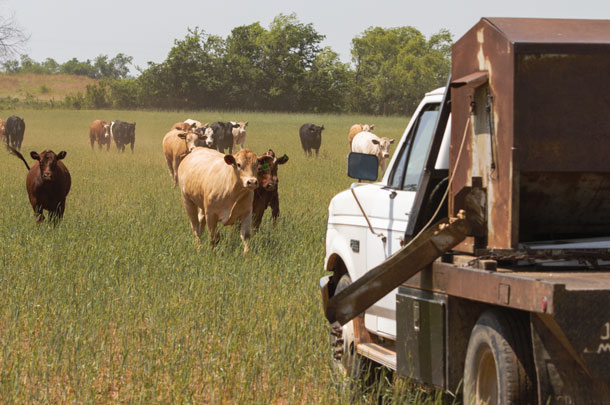There are four main types of nutritional supplementation discussed with stocker cattle grazing wheat pasture: minerals, ionophores, energy feeds and free-choice hay.
Wheat forage is generally marginal to sufficient in phosphorus and magnesium, high in potassium and low in calcium. Therefore, calcium is the mineral that most often limits growth in cattle grazing wheat.
A 550-pound steer gaining 3 pounds per day has a calcium requirement of 33 grams. If the steer is consuming 16 pounds of forage, he is deficient 7.5 grams.
If a steer consumes 2 ounces of mineral per day, then the calcium concentration in the mineral package needs to be 13.2 percent. If mineral intake is higher, calcium concentration can be reduced. Most commercially available wheat pasture mineral packages will be high in calcium (7 to 17 percent) and low in phosphorus (3 to 6 percent).
Data from the Noble Foundation has shown an improvement in average daily gain of 0.2 pounds per day when providing a mineral supplement to cattle on wheat pasture.
Providing an ionophore to cattle grazing wheat pasture is a very economical practice all producers should employ if not raising cattle for a “natural” market. In the same Noble Foundation study, inclusion of the ionophore monensin increased average daily gain 0.2 pounds per day. This increase in gain is additive to the gains shown through mineral supplementation alone.
Ionophore intake should be targeted for 100 to 200 milligrams per day. An ionophore-containing mineral will generally cost approximately $25 per 50-pound sack.
If mineral intake is 3 ounces per head per day, cost per animal is $0.09 per day. Average daily gain is increased by 0.4 pounds per day, which equates to an increase in revenue of $0.20 per head per day if grazing cattle on a cost-per-pound-of- gain basis at $0.50 per pound. Over a 105-day grazing period, each animal profits an additional $11.55.
Supplemental energy in the form of high-starch or high-fiber feedstuffs can be used to increase individual animal gain, decrease performance risk and increase gain per acre through increased stocking rates. Data from Oklahoma State University showed that providing supplemental energy at a rate of 0.65 percent of bodyweight to 533-pound steers increased average daily gain by 0.33 pounds per day over a three-year study.

This results in a supplement conversion ratio on an animal basis of 10.5 to 1. With feed costs at approximately $200 per ton, the value of gain would need to be greater than $1.05 per pound to be economical. Generally, feeding supplemental energy is not done to solely increase individual animal gain but to also increase stocking rate.
In that same Oklahoma State study, providing the additional feed allowed a 33 percent increase in stocking rate, which brings the supplement conversion ratio on a per-acre basis to 5 to 1. With $200-per-ton feed, the value of additional gain would need to be greater than $0.50 per pound to be economical.
This number is much closer to being feasible in today’s market if the producer owns both the wheat and cattle. Remember, to capture this more favorable conversion, the stocking rate must be increased.
Free-choice hay feeding has been used by many to decrease bloat, slow rate of passage and provide another type of forage for any cattle that may be experiencing digestive upset.
Research from Oklahoma State published in the 1980s looked at the effectiveness of this practice. One study evaluated the intake of low-quality hay when cattle are grazing wheat pasture and the resulting performance. Intakes of low-quality hay (wheat straw, 3.6 percent crude protein; sorghum-sudan, 8.5 percent crude protein) were less than 0.5 pounds per head per day.
Average daily gain was not affected by providing low-quality hay from mid-November through late March.
Bloat was also evaluated; however, the incidence of bloat was very low across the treatments. It is unlikely that the very low intakes of low-quality roughage would be effective at reducing bloat.
A second study was conducted to evaluate digestibility of the entire diet when adding low-quality roughages. In this study, steers were hand-fed clipped wheat forage along with the low-quality roughage. The level of low-quality roughage was increased to twice the level observed in the prior grazing study. There was no decrease in wheat forage intake when including low-quality forage – but also no increase in diet digestibility.
When looking at the data as a whole, it appears that providing low-quality roughage to cattle grazing wheat pasture is a practice that provides no benefits but also no detriments.
In summary, the use of supplemental mineral and ionophores for stocker cattle grazing wheat pasture are proven practices that should be employed.
Providing supplemental energy should be evaluated carefully in each situation to ensure that value will be gained from the practice. And lastly, providing free-choice hay is likely an inconsequential practice, as animal intakes are extremely low. ![]()
References omitted due to space but are available upon request. Click here to email an editor.
PHOTO: Stocker cattle can be supplemented with minerals, ionophores, energy feeds and free-choice hay when grazing wheat pasture. Photo courtesy of the Noble Foundation.








